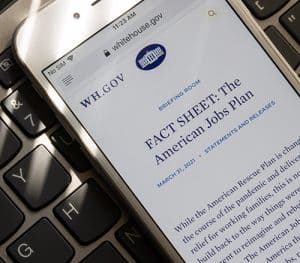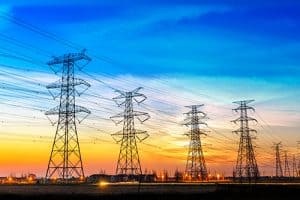
Two trillion dollars is a lot of money. That’s how much the proposed Biden stimulus plan injects into the US economy. To put it in perspective, the major financial crisis spending package in 2009—the American Recovery and Reinvestment Act—only amounted to around $800 billion.
So where is all of this newly proposed stimulus money going, and how can investors win?
Overall the plan, known by its official title “The American Jobs Plan,” injects funding across a broad range of sectors.[1] It does so on a virtually unprecedented scale.
Biden’s infrastructure proposal amounts to the biggest public works program in decades. In the president's own words, it would be “unlike anything we have seen or done since we built the interstate highway system and the space race.”[2]
Project goals include fixing highways, rebuilding bridges, and upgrading ports, airports and transit systems. Clean drinking water, a renewed electrical grid, and access to high-speed broadband are also in, as are rehabilitating and retrofitting affordable, accessible, energy-efficient, and resilient housing, commercial buildings, schools, and child care facilities.
In effect, the plan represents a complete re-boot of the American economy, a re-building of the actual bricks and mortar rather than a fiscal or monetary stimulus measure aimed mainly at financial markets — which is so much of what we’ve seen for the past 30 years.
More than that, the plan addresses many of the critical challenges and opportunities that simply cannot be ignored or buried by political rhetoric. And yes, there will be plenty of opportunity for investors to profit along the way.
The $2 trillion plan is divided into four sectors that include $650 billion for infrastructure, $620 billion for transportation, $580 billion for research and development, and $400 billion for a caretaking economy.
In the infrastructure category, $100 billion has been proposed for improving high-speed broadband networks across the country. In the transportation sector, $174 billion has been set aside for the electric vehicle industry. In the research sector, $300 billion is earmarked to improve local manufacturing.[3]
Building roads means you need materials, right?

America's largest producer of construction aggregates, which includes things like crushed stone, sand and gravel, and a major producer of asphalt and cement, is Vulcan Materials (NYSE: VMC).
Biden’s plan calls for modernizing 20,000 miles of highways, roads, and main streets. It will fix the ten most economically significant bridges in the country in need of reconstruction. It also will repair the worst 10,000 smaller bridges, providing critical linkages to communities.
Note that the administration aims to buy American, and this should suit infrastructure stocks such as Birmingham, Alabama-based Vulcan Materials just fine. It’s as American as apple pie, with more than 360 aggregate facilities scattered across the country. The company has been in business for 64 years and is considered the leader in this space.
In a similar vein is Martin Marietta Materials (NYSE: MLM), a building materials company that specializes in the materials used in large construction and infrastructure projects.
Steel is another vital infrastructure component. Nucor (NYSE: NUE) is the largest domestic steelmaker in North America. Pent-up demand from automakers and other industrial buyers coming out of the pandemic have already massively boosted demand for Nucor’s steel. The American Jobs Plan will throw fuel on that fire.
Infrastructure projects require engineering. California-based AECOM (NYSE: ACM) delivers professional services to program and construction management in the Americas, Europe, the Middle East, Africa, and the Asia Pacific (APAC). It serves transportation, water, government, facilities, environmental, and energy sectors.
The firm recently won a $2 billion US Air Force contract for infrastructure and facilities. Insider Monkey rates AECOM as their number one pick to benefit from the American Jobs Plan, saying “the long-term outlook for the company looks great and with big government projects on the horizon, the stock prices could rise and offer handsome returns to investors.”[4]
Of course, no list of infrastructure stocks would be complete without mention of Caterpillar (NYSE: CAT). The company’s iconic yellow trucks and machinery are ubiquitous in virtually every construction site across the globe. It makes asphalt pavers, compactors, excavators, pipe-layers, backhoes and just about everything else you'd need for a major infrastructure project.

In a release outlining the plan, the Biden administration wrote, “Broadband internet is the new electricity. It is necessary for Americans to do their jobs, to participate equally in school learning, health care, and to stay connected.”[5] The plan calls for $100 billion in infrastructure investment for rural broadband.
One way to play this sector is through the Defiance 5G Next Gen Connectivity ETF (NYSE: FIVG). Investors of FIVG stand to benefit from a broader roll-out of data infrastructure, including cellular antennas and routers, mobile network operators, satellite-based communications, cloud computing equipment, fiber optic cables, data center real estate investment trusts, and much more.
American Tower Corporation (REIT) (NYSE: AMT) is a Boston-based real-estate investment trust that owns and operates mobile phone towers across the world. The company has a market cap of more than $108 billion and posted more than $8 billion in revenue in December 2020.
The expected rollout of 5G communications networks across America is also another factor in the expected future growth of American Tower. Increased wireless data usage and 5G network deployment is expected to drive double-digit capital spending growth.
Applied Materials, Inc. (NASDAQ: AMAT) is a California-based firm that supplies equipment, services and software for the manufacturing of semiconductor chips. These chips find their way into in a wide range of products, including smartphones, laptops, televisions, and solar panels.
As broadband occupies a top priority in the American Jobs Plan, the digital acceleration of the economy from high-speed internet is expected to drive the demand for these chips, leading to a potential gain in the stock value of Applied Materials that has a 20 percent market share in the chip business.
The company has also said that the demand for artificial-intelligence-based data by businesses is expected to lift the semiconductor market to $1 trillion a year by the end of the decade. Leading investment banks like RBC Capital Markets and JP Morgan have taken a bullish stance on Applied Materials stock, rating it as Outperform and Overweight, respectively.

Decarbonization is simply a reality. The post-carbon economy is bursting with new opportunities. Electrification is a key factor.
American Electric Power Company (NASDAQ: AEP) could gain from the American Jobs Plan as it owns the largest electricity transmission system in the country. The firm also has a stake in the electrical transmission system of Texas, a state that the administration has singled out as long overdue for an upgrade in electric transmission.
AEP operates through Vertically Integrated Utilities, Transmission and Distribution Utilities, AEP Transmission Holdco, and Generation & Marketing segments. The company generates electricity using coal and lignite, natural gas, nuclear, and hydroelectric, as well as solar, wind, and other energy sources. It also supplies and markets electric power at wholesale to other electric utility companies, rural electric cooperatives, municipalities, and other market participants.
Firms like American Electric were on the growth trajectory as they moved away from coal power and towards clean energy in line with government initiatives. The new administration’s plans will arguably accelerate that growth.
The administration appears to be serious about retaking leadership in the electric vehicle space from China and is proposing a $174 billion investment to make that happen.
In part, the plan calls for building 500,000 electric vehicle charging stations across the country by 2030. To give perspective on just how big that is, there are around 115,000 gas stations in the United States.
That build-out should directly benefit companies such as Charge Point Holdings (NYSE: CHPT). ChargePoint builds customized charging stations, and has been in this business since 2007, long before electric vehicles were on the radar of most investors. The company has delivered more than 90 million charges and claims 60 percent of the Fortune 50 companies as clients.

You may not think much of taking a hot shower after work, grabbing a glass of water from the sink, or flushing the toilet and washing your hands—but the water you use for all of these things has become rarer and harder to get by the minute.
Even though 70 percent of the Earth is water, only one percent of it is clean enough for human consumption. The rest is either trapped in glaciers or is salty ocean water. Even worse is the fact that the water we have easy access to is often wasted.
The water infrastructure in the US is old and poorly maintained. The American Society of Civil Engineers (ASCE) gave the entire pipeline system a D+ grade in a recent comprehensive report card.
Factors that lead to this dreadful grade include an estimated 240,000 water main breaks per year and an estimated 6 billion gallons of water wasted every day. And that's just from the water that gets to us and isn't used properly; another 7 billion gallons simply leaks out of pipes never to be seen by anyone.
The ASCE has estimated that the US will need to spend as much as $4.5 trillion to fix its failing infrastructure by 2025, and $108 billion of this will have to go toward water and wastewater structures alone.[6]
Evoqua Water Technologies Corp. (NYSE: AQUA) provides water and wastewater treatment systems and technologies, and mobile and emergency water supply solutions and services for industrial, commercial, and municipal water treatment markets.
The firm offers systems and related recurring services for treating industrial process water, utility water, and wastewater. It has served the healthcare, pharmaceutical, food and beverage, and other industries. Evoqua also makes products that filter and separate clean and dirty water. Since the American Jobs Plan envisions the provision of clean water to every American household, the firm is in a great position to grow going forward.
Badger Meter Inc. (NYSE: BMI) is a US company with a wide reach. It sells mechanical and electronic water meters and products to measure and control goods that travel via pipes. These include water, wastewater, oil, and gas, among other things. Badger's meters monitor water usage so customers can be aware of what they’re using and what the utilities are charging them for. The utilities use them for billing as well. Seventy-five percent of the company's meter sales go to municipal water systems.
Itron Inc. (NASDAQ: ITRI) offers similar meters for electricity, gas, and water. Its meters also measure use of water for both residential and business use. Like Badger, the information is available through software, so customers can always be aware of the data being collected. Itron, however, goes a step further in offering data interpretation as a service.
First, Itron has analysis software available to customers which uses the collected data to make short- and long-term predictions about the customer’s water use and costs. It also has a subsidiary called Private Cloud which allows businesses to save their usage information and consult with Itron experts to come up with efficiency solutions. Those experts are available for consultations for all customers. The company’s Professional Services include installation services, system maintenance and training, and technical support.
A large part of the time, the investment world can be a confusing and highly uncertain place. Investors so often have a tricky time deciding which direction to go. But every so often, opportunities arise that are so obvious nobody should miss them.
That was the case in the early days of the Internet, and later of the cannabis revolution, and more recently in the copper market.
The need for revamped infrastructure in the US has been blatantly obvious for years. That the federal administration is now taking desperately needed action should come as no surprise, and the investment opportunities are, as a result, especially rich.
So whether you pick a stock, a sector, or an ETF, the probability that the money invested will produce a handsome returns is high. America needs renewal, and this is your chance to win.

Blake Desaulniers, Contributor
for Investors News Service
P.S. To discover more opportunities in the hottest sectors in North America, sign up now to the Financial News Now newsletter to get the latest updates and investment ideas directly in your inbox!
DISCLAIMER: Investing in any securities is highly speculative. Please be sure to always do your own due diligence before making any investment decisions. Read our full disclaimer here.
[1] https://www.whitehouse.gov/briefing-room/statements-releases/2021/03/31/fact-sheet-the-american-jobs-plan/
[2] https://www.kiplinger.com/investing/stocks/stocks-to-buy/602447/best-infrastructure-stocks-biden-next-spending-plan
[3] https://finance.yahoo.com/news/10-best-stocks-gain-biden-122516662.html
[4] https://www.insidermonkey.com/blog/5-best-stocks-that-will-gain-from-bidens-job-and-infrastructure-plan-931661/5/
[5] https://www.marketwatch.com/story/here-are-the-etfs-to-help-you-invest-in-the-biden-infrastructure-plan-11617218128
[6] https://www.energyandcapital.com/report/water-investing-101-the-best-water-stocks-to-buy/190